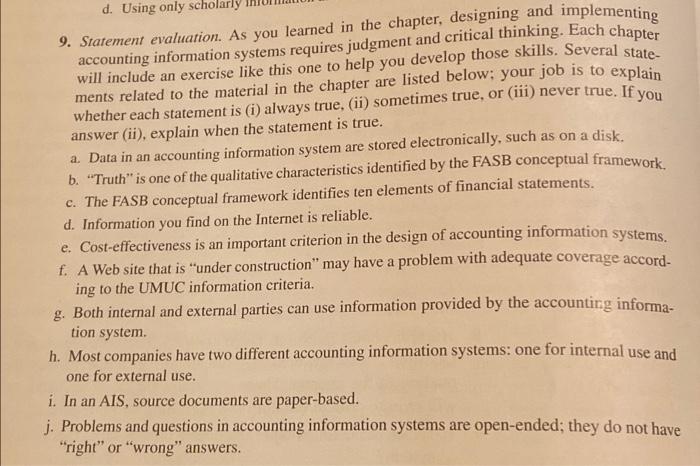Answered step by step
Verified Expert Solution
Question
1 Approved Answer
d. Using only scholarly 9. Statement evaluation. As you learned in the chapter, designing and implementing accounting information systems requires judgment and critical thinking. Each
d. Using only scholarly 9. Statement evaluation. As you learned in the chapter, designing and implementing accounting information systems requires judgment and critical thinking. Each chapter will include an exercise like this one to help you develop those skills. Several state- ments related to the material in the chapter are listed below; your job is to explain whether each statement is (i) always true, (ii) sometimes true, or (iii) never true. If you answer (ii), explain when the statement is true. a. Data in an accounting information system are stored electronically, such as on a disk. b. "Truth" is one of the qualitative characteristics identified by the FASB conceptual framework c. The FASB conceptual framework identifies ten elements of financial statements. d. Information you find on the Internet is reliable. e. Cost-effectiveness is an important criterion in the design of accounting information systems. f. A Web site that is "under construction" may have a problem with adequate coverage accord- ing to the UMUC information criteria. g. Both internal and external parties can use information provided by the accounting informa- tion system. h. Most companies have two different accounting information systems: one for internal use and one for external use. i. In an AIS, source documents are paper-based. j. Problems and questions in accounting information systems are open-ended; they do not have "right" or "wrong" answers.

Step by Step Solution
There are 3 Steps involved in it
Step: 1

Get Instant Access to Expert-Tailored Solutions
See step-by-step solutions with expert insights and AI powered tools for academic success
Step: 2

Step: 3

Ace Your Homework with AI
Get the answers you need in no time with our AI-driven, step-by-step assistance
Get Started


